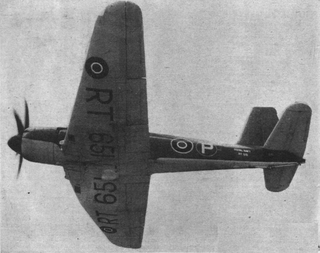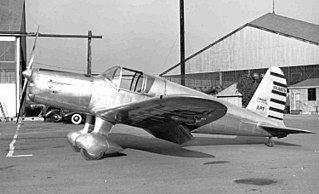
The SAI KZ III Laerke was a Danish light utility aircraft used by the Danish Air Ambulance Service and Danish Air Force.

The VEF I-12 was a tandem, two seat Latvian trainer aircraft designed by Kārlis Irbītis and produced by VEF in Riga.

The Blackburn B.48 Firecrest, given the SBAC designation YA.1, was a single-engine naval strike fighter built by Blackburn Aircraft for service with the British Fleet Air Arm during the Second World War. It was a development of the troubled Firebrand, designed to Air Ministry Specification S.28/43, for an improved aircraft more suited to carrier operations. Three prototypes were ordered with the company designation of B-48 and the informal name of "Firecrest", but only two of them actually flew. The development of the aircraft was prolonged by significant design changes and slow deliveries of components, but the determination by the Ministry of Supply in 1946 that the airframe did not meet the requirements for a strike fighter doomed the aircraft. Construction of two of the prototypes was continued to gain flight-test data and the third was allocated to strength testing. The two flying aircraft were sold back to Blackburn in 1950 for disposal and the other aircraft survived until 1952.

The AISA I-115 is a low-wing single-engined military primary trainer with tandem seating, which went into service with the Spanish Air Force in 1956. After retirement in 1976 many were sold to civil operators.
The TeST TST-13 Junior is a single-seat touring motor glider with a nose-mounted engine, built by TeST in Czech Republic. It is an all composite design which succeeded the TeST TST-9 Junior motor glider in production, incorporating some features of the TeST TST-10 Atlas sailplane, including its wing.

The Hirth Hi 27 Acrostar was designed by Arnold Wagner to win aerobatic competitions, in part by having handling independent of orientation, upright or inverted. A single engine, single seat low-wing monoplane, it was built in West Germany by Wolf Hirth GmbH in the early 1970s, and dominated Championships for a brief period.

The IAR-22 was a single engine basic trainer built in Romania in about 1934. It was a low-wing monoplane with two seats in tandem and a fixed conventional undercarriage.
The I.S.T. L-17 Masang was a two-seat, single engine, low wing monoplane aircraft designed and built in the Philippine Republic in the mid-1950s. It was intended for both touring and training.

The TL Ultralight TL-132 Condor and TL-232 Condor Plus are single engine, highwing ultralight aircraft designed and built in the Czech Republic in the mid-1990s. They remain in production in 2010.

The Roko Aero NG4 is a single-engined sport aircraft, available in both light-sport aircraft and ultralight models, which seats two side by side. It is in production in the Czech Republic.

The Aviamilano F.14 Nibbio is a four-seat, single engine cabin monoplane built in Italy in the late 1950s. Only ten production aircraft were completed.
The Starck AS-37 is a two-seat biplane with unconventional wing and propulsion layouts. It was designed in France in the 1970s; though three were built and more than twenty sets of plans sold for home building, no AS-37s are active in 2012.
The Toyo Kukku T-T.10 is a low wing, single engine training aircraft which seats two in tandem. It was designed and built in Japan in 1952.

The Sud-Est or SNCASE SE-2100, sometimes known as the Satre SE-2100 after its designer, was a tailless, pusher configuration touring monoplane with a single engine and cabin for two. Only one was built.

The Coupé-Aviation JC-01 is the first of a series of very similar designs of two seat, single engine sports aircraft, amateur built from plans in France from 1976. These provided a range of engine sizes and undercarriage layouts, but total production was small.
The Stephens Akro is a single engine monoplane designed in the United States for aerobatic competitions. It first flew in 1967 and proved very successful, leading to several developments of which one won seven US Championships and one World Championship between 1975 and 1982. The Extra EA-230 and Extra EA-300 were also Akro developments with over two hundred built.

The Caudron C.430 Rafale was a fast, two seat French touring monoplane. Soon after its first flight in 1933 it set an international class speed record.
The Caudron C.580 was a French advanced trainer aircraft intended to prepare pilots for the new low wing monoplane fighters of the mid-1930s. It did not go into production and only two were built.

The Aeroneer 1-B is an all-metal light aircraft built in the United States in 1936. It did not reach production, despite an attempt to interest the USAAC in it as a trainer, but it appeared in three Hollywood films.
The Möller Stomo 3 was a small, low-powered but very aerodynamically-clean light aircraft, first flown in Germany in 1939. It set two speed over distance records for aircraft with engines of less than 2 l (120 cu in) capacity soon after its first flight.













